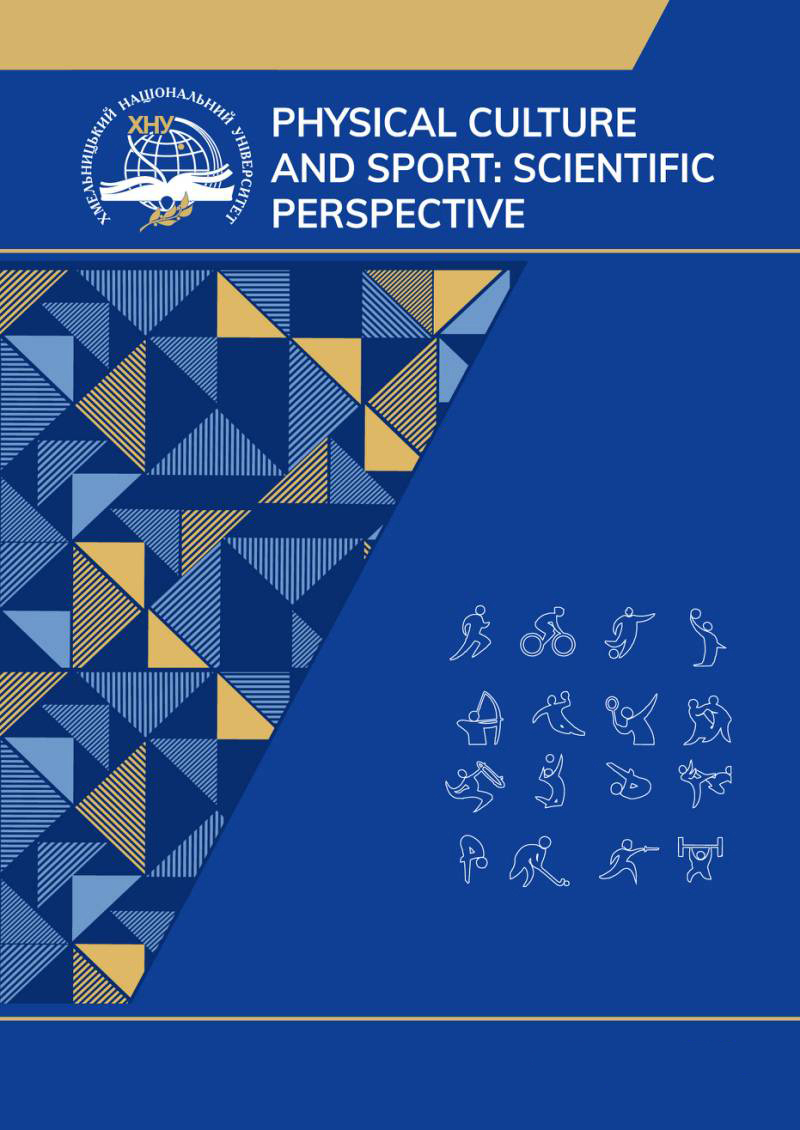MUSIC GAMES AS A MEANS OF DEVELOPMENT OF COORDINATION ABILITIES IN AEROBIC GYMNASTICS
DOI:
https://doi.org/10.31891/pcs.2024.3.14Keywords:
aerobic gymnastics, athletes, basic training groups, coordination abilities, sports trainingAbstract
Modern training of athletes in aerobic gymnastics requires an integrated approach, which includes not only the development of strength and endurance, but also the improvement of coordination, flexibility and special techniques for performing elements. With the development of this young sport, the requirements for gymnasts have become much higher, and training has become much more complicated. Modern coaches make programs taking into account the physical capabilities and level of training of each athlete, which increases efficiency and reduces the risk of injury. In aerobic gymnastics, much attention is paid to exercises to develop body balance and accuracy of movements, cultivate a sense of rhythm and synchronize the performance of the composition with musical accompaniment. The use of special simulators and stabilization exercises help athletes improve body control, which is necessary when performing complex combinations, but they do not affect the development of rhythm and coherence of movements with music. The article considers the effectiveness of the program of development of coordination abilities of athletes of the basic training group using music games. When developing the program, the choice of music games was appropriate in relation to the development of types of coordination abilities (temporo-spatial orientation, rhythm, evaluation and regulation of movement parameters, maintaining balance, muscle feeling). The implementation of this program showed a positive effect on the development of coordination abilities and showed a likely improvement in the performance of the tests: rhythmic tapping with hands (p < 0.05), the flamingo balance test 1 minute (p < 0.10), the Kopylov test (p < 0.05), jumping to the markup (p < 0.05). So, music games help to improve balance, synchronization of movements, rhythm and reaction speed, which are key to success in aerobic gymnastics.
References
Hryhorenko, H. V. Hryhorenko, D. P. Vasyliev, Yu. S. (2021). Sportyvno-ihrovi metody v strukturi navchalnykh zaniat, spriamovanykh na rozvytok rukhovykh zdibnostei shkoliariv. Pedahohika i psykholohiia v suchasnomu sviti: mystetstvo navchannia, 2021.S. 157-160.10.30525/978-9934-26-041-4-40.
Kolumbet O.M. Rozvytok koordynatsiinykh zdibnostei molodi. Monohrafiia.K.:Osvita Ukrainy, 2014.420s.
Bodrenkova I. Features of development of coordination abilities features of athletes in sports aerobics in initial training. Pedagogics, psychology, medical-biological problems of physical training and sports, 2014. Vol. 18(12). pp. 13-17. Doi. 10.15561/18189172.2014.1203
Stanković A., Mijalković S., Petković E., Sahin F. N., Stanković D. Coordination in some of the basic individual sports: a systematic review. Turk J Kinesiol, 2023. Vol.9(4). Pp.280-286. DOI: 10.31459/turkjkin.1368725
Smits-Engelsman, Bouwien & Hill, Elisabeth. The Relationship Between Motor Coordination and Intelligence Across the IQ Range. PEDIATRICS, 2012. Vol. 130. Pp. 950-956.
Petković E. The relation of situational-motor coordination to the competitive success of female gymnasts. FU Phys Ed Sport, 2004. Vol. 2(1), Pp.25-33.
Smîdu N. The importance of coordinative abilities in achieving athletic performance. Marathon, 2014. Vol.1(1). Pp. 91-95.
Stanković D., Pavlović V., Petković E. The influence of coordination on the results in sports climbing: the underlying relations. In N. Stojiljković (Ed.), Book of Proceedings XXII International Scientific Conference ‘‘FIS Communications 2019’’ in Physical Education, Sport and Recreation, October, 17-19, 2019. Pp. 21-26.
Vandorpe B, Vandendriessche JB, Vaeyens R, Pion J, Lefevre J, Philippaerts RM, Lenoir M. The value of a non-sport-specific motor test battery in predicting performance in young female gymnasts. Journal of Sports Sciences. 2012; Vol.30. Pp. 497–505. doi: 10.1080/02640414.2012.654399.
Lyakh V, Jaworski J, Wieczorek T. Genetic endowment of coordination motor abilities a review of family and twin research. Journal of Human Kinetics. 2007, Vol.17. Pp. 25–40.
Vilchkovska A. Osoblyvosti intehratsii muzyky y rukhovoi diialnosti shkoliariv u protsesi fizychnoho vykhovannia. Fizychne vykhovannia, sport i kultura zdorovia u suchasnomu suspilstvi, 2019. №3(47). S.10–16. https://doi.org/10.29038/2220-7481-2019-03
Vilchkovska A. Zastosuvannia muzyky v ihrovii diialnosti ditei doshkilnoho viku. Physical education, sport and health culture in modern society, 2018. №2 (42). С. 33-37.
Kravchuk T., Riadynska I., Miahka V. Efektyvnist vykorystannia tantsiuvalno-himnastychnykh rozmynok yak zasobu muzychno-rukhovoi pidhotovky sportsmenok u skladnokoordynatsiinykh vydakh sportu (na prykladi chyrlidynhu). Naukovyi chasopys Ukrainskoho derzhavnoho universytetu imeni Mykhaila Drahomanova, 2023. № 12(172). S.107-113.https://doi.org/10.31392/UDU-nc.series15.2023.12(172).20
Terry P.C., Karageorghis C.I., Curran M.L., Martin O.V., Parsons-Smith R.L. Effects of music in exercise and sport: A meta-analytic review. Psychol. Bull, 2020. Vol.146(2). Pp. 91-117. doi: 10.1037/bul0000216.
Chtourou H., Hmida C., Souissi N. Effect of music on short-term maximal performance: Sprinters vs. long distance runners. Sport Sci. Health, 2017. Vol.13.Pp.213–216. doi: 10.1007/s11332-017-0357-6.
Ballmann C.G., Maynard D.J., Lafoon Z.N., Marshall M.R., Williams T.D., Rogers R.R. Effects of Listening to Preferred versus Non-Preferred Music on Repeated Wingate Anaerobic Test Performance. Sports, 2019. Vol.7(8).Pp.185. doi: 10.3390/sports7080185.
Kravchuk T. M., Holenkova Yu. V., Koviakh K. V. Rozvytok zdibnosti do rytmichnoi diialnosti zasobamy muzychnykh ihor na pochatkovomu etapi bahatorichnoho trenuvannia v akrobatychnomu rok-n-roli. Tekhnolohii zberezhennia zdorovia, reabilitatsiia i fizychna terapiia : zb. st. XIII mizhnar. nauk. konf. Kharkiv; Torun, 2020. S. 100–108.https://doi.org/10.26697/9786177089000.2017.112
Kokarev, B.V. Udoskonalennia sportyvno–psykholohichnykh aspektiv adaptatsii sportsmeniv u sportyvnii aerobitsi. Visnyk Chernihivskoho natsionalnoho pedahohichnoho universytetu. Seriia: Pedahohichni nauky. Fizychne vykhovannia ta sport. 2014; 118 (4): 79–82.Пасічна, Т. В., Мохорт, Л. В., Лозенко, Н. М. Спортивна аеробіка навчальна програма для дитячо-юнацьких спортивних шкіл / Київ : ФУСАФ, 2019. -98 с.
Artemieva H., Bodrenkova I., Moshenska T. Udoskonalennia spetsialnoi fizychnoi pidhotovky himnastok u sportyvnii aerobitsi na etapi pochatkovoi pidhotovky. Slobozhanskyi naukovo-sportyvnyi visnyk. 2019. № 5. S. 76-81.http://nbuv.gov.ua/UJRN/snsv_2019_5_15
Kravchuk T.M., Sanzharova N.M., Tiutiuma A. Ya. Muzychno-rukhova pidhotovka na pochatkovomu etapi bahatorichnoho trenuvannia v sportyvnii himnastytsi. Tekhnolohii zberezhennia zdorovia, reabilitatsiia i fizychna terapiia, 2019. S.137–143.
Skumin A., Holenkova Yu. Rukhlyvi ihry yak zasib rozvytku fizychnykh zdibnostei yunykh sportsmenok, yaki zaimaiutsia sportyvnoiu aerobikoiu. Fizychna kultura i sport. Vyklyky suchasnosti, 2023.№ 8. S.32-41.https://doi.org/10.5281/zenodo.10251860
Downloads
Published
How to Cite
Issue
Section
License
Copyright (c) 2024 Юлія ГОЛЕНКОВА , Ірина РЯДИНСЬКА , Олена ФЕСЕНКО

This work is licensed under a Creative Commons Attribution 4.0 International License.





